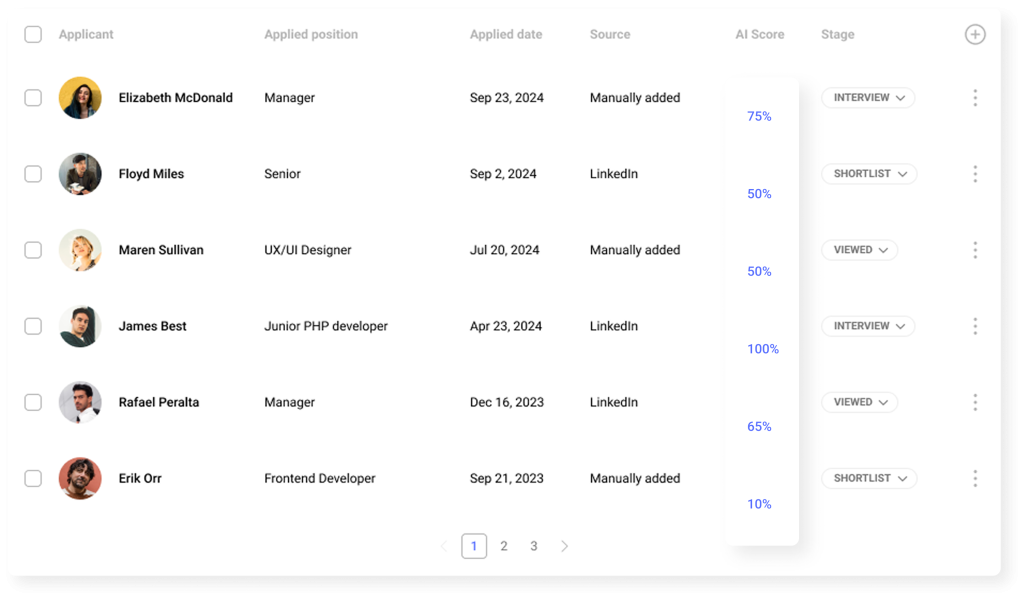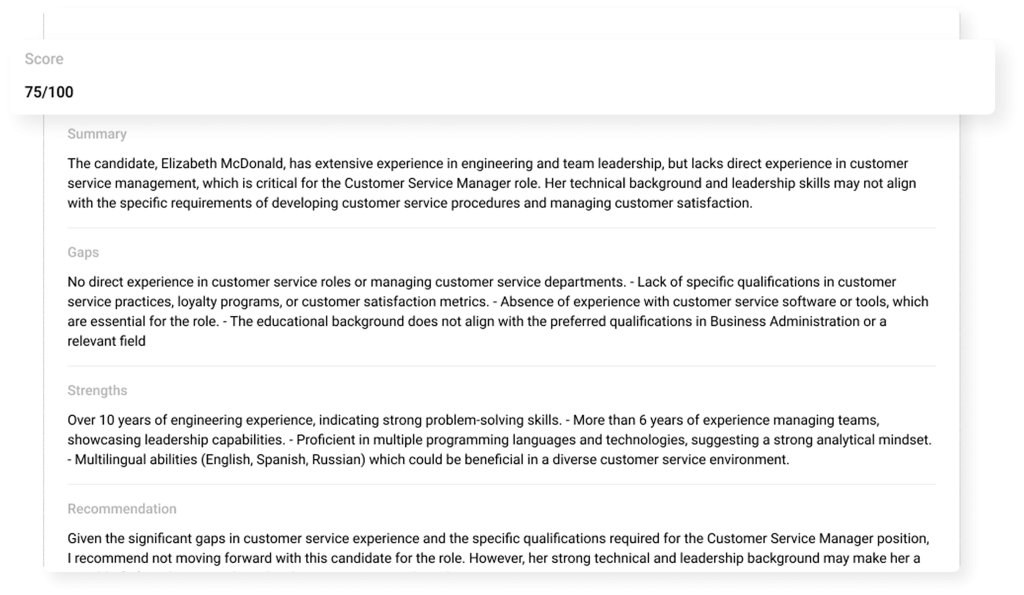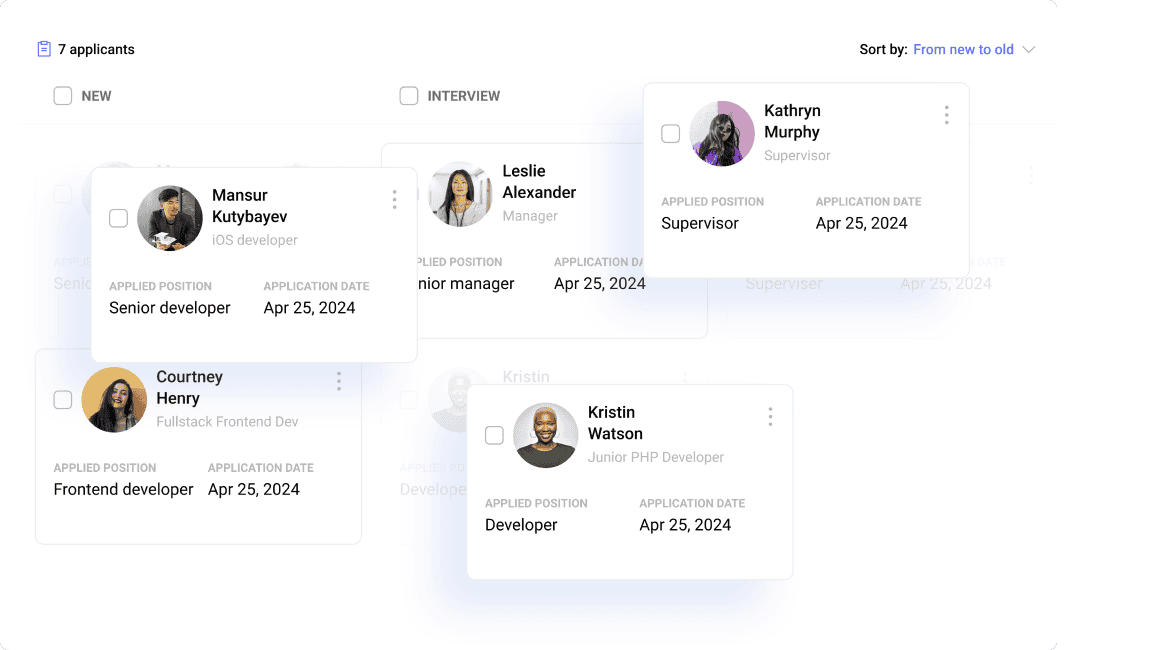Table of Contents
ToggleWhat Is Candidate Screening and Why Is It Important?
Candidate screening is a crucial step in the recruitment process that involves evaluating job applicants to determine their suitability for a specific role. It serves as the initial filter that helps hiring teams identify candidates who meet the minimum requirements and show the potential to succeed. The process typically includes reviewing resumes, cover letters, and application forms, conducting initial interviews, and sometimes administering assessments or background checks.
Candidate screening aims to narrow down a large pool of applicants to a more manageable shortlist of qualified individuals, saving time and resources for both recruiters and hiring managers. Effective screening ensures that only the most relevant and capable candidates move forward in the hiring process, leading to better hiring decisions and improved employee retention. Given its impact on recruitment quality and efficiency, candidate screening is one of the most important stages of talent acquisition.
Manual vs. Automated Candidate Screening
Manual candidate screening involves recruiters or hiring managers reviewing resumes and applications one by one, comparing qualifications against job requirements, and making judgments based on their own observations. While this traditional method allows for a more personal touch, it is often time-consuming, inconsistent, and vulnerable to human bias. Screening hundreds of applications manually can lead to overlooked talent and delayed hiring decisions.
In contrast, automated candidate screening uses technology, often powered by AI or algorithms, to parse resumes, assess qualifications, and rank candidates based on predefined criteria. These tools can quickly analyze large volumes of applications, highlight the most suitable candidates, and ensure a more standardized evaluation process. Automation not only saves time but also reduces human error and helps eliminate unconscious bias, making the recruitment process more efficient and fair.

Why Employers Are Turning to Automated Screening
As the volume of job applications continues to rise, employers are increasingly adopting automated screening tools to enhance efficiency and improve hiring outcomes. According to a study by Ideal, AI-powered resume screening can reduce screening time by up to 75% and increase the quality of shortlisted candidates by 67%.
Automated screening systems utilize algorithms and machine learning to analyze resumes, identify key skills and experiences, and match candidates to job descriptions. For instance, when hiring for a software engineering position, an automated tool can swiftly parse through numerous applications, filter candidates proficient in specific programming languages, and generate a shortlist based on predefined criteria. This not only accelerates the hiring process steps but also ensures a more objective and consistent evaluation of candidates.
What Are The Benefits of Automated Candidate Screening
Automated candidate screening transforms the hiring process by addressing some of the most common and costly recruitment challenges. With the help of advanced recruitment software, it helps organize the recruitment workload, allowing recruiters to focus on high-potential candidates, reduces time-to-hire without compromising screening quality, eliminates unconscious bias, and enables scalable recruitment by maintaining consistency and accuracy. Together, these benefits empower hiring teams to work smarter, hire faster, and build stronger, more diverse teams.
Organizing The Recruitment Workload
Recruiters today face an overwhelming challenge: the volume of applicants. With job applications just a click away, recruiters are inundated with resumes, many of which are unqualified for the role. Studies show that 88% of applicants are not suited for the positions they apply for, leading to hours of wasted time sifting through irrelevant profiles. This can result in recruiter burnout and fatigue, as they manually filter through resumes, a process that is both time-consuming and prone to error.
Automated candidate screening alleviates this pain by efficiently filtering applicants at scale. Using AI-powered resume parsing, keyword matching, and rule-based logic, these tools help identify the most relevant candidates by automatically ranking resumes based on the job’s requirements. This means recruiters can focus on high-priority candidates, accelerating the process and improving the quality of hires. With automated systems, recruiters no longer need to sift through every resume individually; the technology does the heavy lifting, saving time and reducing stress.
By applying principles like the Pareto Principle (80/20 rule), recruiters can focus their efforts on the top 20% of applicants, who are likely to produce 80% of the desired results. This strategic prioritization helps streamline the recruitment process, enabling teams to work more efficiently and hire with greater accuracy.
This approach is especially valuable for small teams juggling multiple responsibilities. Startups, for example, often don’t have the time or resources to review hundreds of applications manually. That’s why recruiting for startups can benefit immensely from automation; it ensures better hires, faster, with less stress.
Reduce Time-to-Hire While Maintaining Screening Quality
Automatically weeding out irrelevant applications and being able to review and contact the top matching candidates straight from the applicant list also translates to a reduced time to hire. Yello’s 2020 survey suggests that recruiters spend most of their time screening candidates, with 60% of the respondents identifying candidate screening as the most time-consuming step of the hiring process. A lot of time is wasted trying to obtain basic yet key information that a CV parser could obtain a hundred times over.
A healthy balance is needed between human screening and AI screening to reduce the time to hire without killing efficiency. On one hand, overly relying on AI screening can result in the elimination of top candidates, and on the other hand, overly relying on human screeners can result in a slow and sluggish process, which can lead to a shortage of time to review all candidates. The perfect solution for employers is to be able to review all candidates at different levels of depth, first trimming down the entire volume of candidates into a manageable workload by weeding out irrelevant applications, and then managing the workload manually with more in-depth screening.
Eliminating Hiring Biases and Advancing DEI with AI
AI-powered candidate screening plays a pivotal role in reducing unconscious bias throughout the hiring process. Traditional hiring methods, such as manual resume reviews, often inadvertently favor certain demographics or experiences, perpetuating biases based on gender, race, or educational background. By automating the initial stages of candidate evaluation, AI removes subjective judgments that can influence hiring decisions. These tools are designed to focus solely on qualifications, skills, and experience, ensuring that each candidate is evaluated fairly based on their merit rather than extraneous factors.
The ability to mitigate bias in hiring directly contributes to advancing Diversity, Equity, and Inclusion (DEI) initiatives. AI enables recruiters to evaluate a broader, more diverse pool of applicants without the influence of unconscious biases, leading to more equitable hiring practices. This fosters a culture of inclusion, where candidates from different backgrounds and experiences have an equal opportunity to be considered for the job, promoting a more diverse and representative workforce. As a result, organizations can build more dynamic, innovative teams, which positively impact their overall culture and success.

Scaling Your Hiring Process Efficiently
Scaling a recruitment process can be one of the biggest challenges as your company grows, especially when you need to hire in high volumes. Whether you’re looking to hire 10 engineers in a month or 50 customer support representatives in a quarter, manually screening thousands of resumes can quickly become overwhelming and inefficient. The core value of automated candidate screening lies in its ability to handle these large volumes with speed and accuracy.
By automating the initial stages of candidate evaluation, using AI to parse resumes, identify key qualifications, and rank candidates accordingly, you can ensure that no qualified applicant slips through the cracks while efficiently narrowing down your pool of candidates. This approach saves valuable time, reduces recruiter burnout, and speeds up the hiring process, allowing your team to focus on making final hiring decisions rather than sorting through countless resumes.
With automated screening, scaling your hiring process becomes manageable, even as the demands for new talent grow. Automation ensures that every application is treated with the same level of care and consideration, without slowing down the recruitment timeline.
How Automated Candidate Screening Works
Having extensively discussed all the key benefits of automated candidate screening, the only thing left to cover is exactly how it works. Automated candidate screening streamlines the recruitment process by using AI and algorithms to evaluate resumes more efficiently and accurately. Among the various methods of candidate screening, automation typically starts with resume parsing, where the AI extracts relevant information from a candidate’s resume, such as their contact details, experience, skills, and education. Keyword extraction comes next, where the system identifies specific terms that match the job description, helping to assess a candidate’s suitability for the role. Finally, scoring involves ranking the candidate based on how well their qualifications align with the job requirements, often assigning a score that makes it easier for recruiters to prioritize candidates.
Structured data plays a crucial role in this process, as it allows for more accurate parsing and matching. For instance, when resumes are submitted in standardized formats like PDFs or Word documents, the AI can more easily parse the content. However, not all formats are supported by every resume parser. While PDFs and Word docs are widely supported, other formats like images or poorly formatted text might lead to less accurate results. This is why it’s essential to ensure that candidates are submitting in formats compatible with the system to maximize the accuracy of the screening process.
Separating The Job Description Into Parts
Breaking down the job description into clearly defined parts helps both AI and human readers process and understand the role’s requirements more effectively. This structured approach allows for better alignment between the job description and candidate qualifications. The key components typically include:
- Professional Skills: These are the specific competencies and abilities required for the job, such as technical skills or industry knowledge.
- Personal Skills: These soft skills, such as communication or leadership, highlight traits that complement professional capabilities.
- Required Qualifications: This section includes formal education, certifications, and work experience that are mandatory for the position.
- Job-Specific/Technical Skills: These are the specialized abilities needed to succeed in the job, such as coding languages for a software developer or machinery operation for an engineer.
By breaking the job description into these parts, both AI and human readers can easily identify the most relevant qualifications, enhancing the accuracy of the automated screening process. This structured approach ensures that AI parses the content with high precision, helping candidates and recruiters alike quickly focus on the most important aspects of the role.
Creating Custom Application Forms
Custom application forms are essential for tailoring the hiring process to your company’s specific needs. These forms allow you to gather relevant information about each candidate that goes beyond a generic resume. For instance, you might include fields for work samples, availability, or preferred working hours, which can give you more insights into whether a candidate is a good fit for the role.
By customizing application forms and integrating them with candidate screening software, you can streamline the process of candidate relationship management (CRM). The data collected from these forms can be used to track applicant progress, manage communications, and even segment candidates based on their preferences and qualifications. For example, you could ask candidates for specific work samples or case studies relevant to the role, allowing for more comprehensive assessments early in the process.
A creative approach to your forms, such as incorporating skill tests or situational questions, can help identify the best talent more effectively. This customization not only enhances the candidate experience but also ensures that the application process is tailored to meet your company’s needs, making it easier to assess candidates with the right qualifications.
Conclusion
Adopting automated candidate screening isn’t just about saving time: it’s a strategic advantage in today’s highly competitive hiring landscape. As talent acquisition becomes more complex and fast-paced, automation equips recruiters with the tools to handle growing volumes of applicants without sacrificing quality or fairness.
Throughout this article, we explored how automation helps organize recruitment workloads, significantly reducing recruiter burnout and filtering out unqualified applicants early in the process. We also highlighted how it improves time-to-hire by streamlining repetitive tasks and ensuring only the most relevant candidates make it through. Furthermore, reducing hiring bias with AI not only enhances objectivity but also supports meaningful progress toward diversity, equity, and inclusion (DEI). And when it comes to growth, automation enables companies to scale their hiring processes efficiently without adding headcount or compromising the candidate experience.
In a world where speed, fairness, and efficiency are paramount, automated candidate screening positions companies to attract top talent, enhance hiring quality, and stay ahead of the competition. It’s not just a tool, it’s a shift toward a more intelligent, inclusive, and future-ready recruitment process.
Experience the full power of Hirebee.ai with our 14-day free trial, and unlock access to all features while also getting a personalized demo tailored to your needs.









